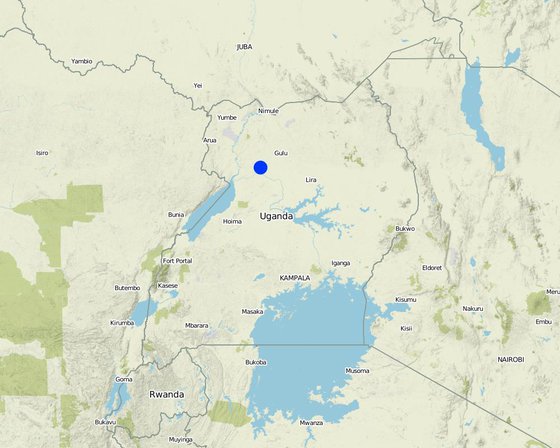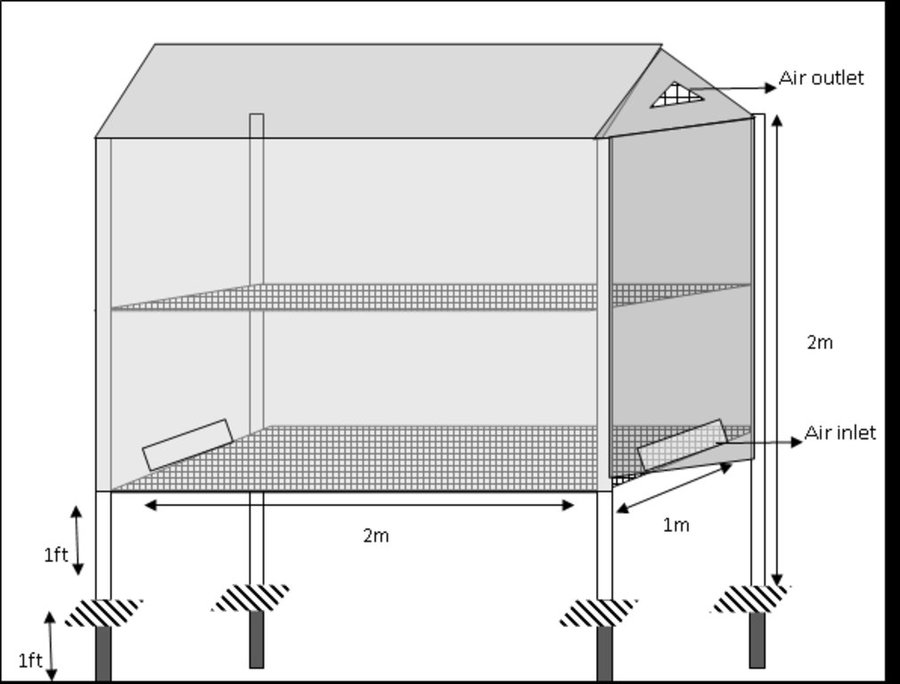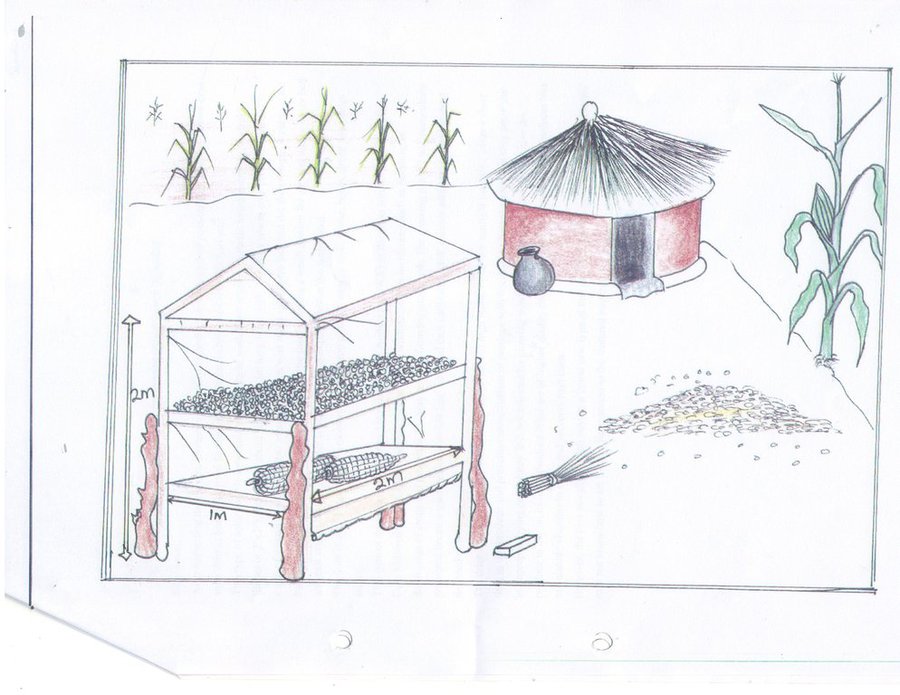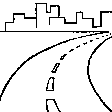Low-cost solar drier for preserving crop produce
(Ouganda)
twoyo cam ki cheny
Description
A portable wooden frame solar drier with polythene cover used for drying low moisture content crop produce such as chili and maize. The crop is placed inside the drier and takes 2-3 days to dry depending on the humidity and moisture content at harvest.
Postharvest crop losses constitute a major concern among farming communities in northern Uganda. This is primarily due to suboptimal drying facilities used by farmers, despite the availability of all year round natural solar radiation. It was in light of this challenge that the Uganda Wildlife Authority (UWA) introduced and promoted a low-cost handy solar drier among the rural farming communities in and around the Murchison Falls National Park. The purpose was to reduce human wildlife conflict incidences such as poaching or destruction of crops and properties by stray animals from the game park. The technology bears potential for out scaling to other non-targeted communities as well.
The drier consists of a wooden frame made from locally available wood material (preferably timber of 2" x 3"), measuring about 1 m wide by 2 m long and 2 m high. The floor where crop produce is placed is made of mesh of materials such as wire mesh or papyrus mat. The entire frame is surrounded by a 0.2 mm thick transparent UV stabilized plastic sheet, leaving a small portion for air inlet on the lower bed and exit vent at the top. The drier is placed in an open air place within the homestead.
The drier is most suited for drying low moisture content crop produce such as chili, maize, beans and green vegetables.
The drier is able to dry crop produce during periods of high humidity or low sunlight intensity, cover a short time to dry produce and prevents contamination of produce with bacterial or fungal spores that may occur due to improper drying procedures. It is not affected by blowing wind or rainfall; thus a farmer can leave the produce to dry on its own. Produce dried are of higher quality than when dried in open sun. The drier also reduces loss of valuable vitamins in fruits and prevents fruit burning. However, the cost associated with buying a brand new type of this drier made from modern materials is high.
Lieu

Lieu: Anaka sub-county, Agung village, Nwoya district, Ouganda
Nbr de sites de la Technologie analysés: 2-10 sites
Géo-référence des sites sélectionnés
Diffusion de la Technologie: appliquée en des points spécifiques ou concentrée sur une petite surface
Dans des zones protégées en permanence ?:
Date de mise en oeuvre: il y a moins de 10 ans (récemment)
Type d'introduction
-
grâce à l'innovation d'exploitants des terres
-
dans le cadre d'un système traditionnel (> 50 ans)
-
au cours d'expérimentations / de recherches
-
par le biais de projets/ d'interventions extérieures

Solar drier (Issa Aiga)

Solar drier (Issa Aiga)
Classification de la Technologie
Principal objectif
-
améliorer la production
-
réduire, prévenir, restaurer les terres dégradées
-
préserver l'écosystème
-
protéger un bassin versant/ des zones situées en aval - en combinaison avec d'autres technologies
-
conserver/ améliorer la biodiversité
-
réduire les risques de catastrophes
-
s'adapter au changement et aux extrêmes climatiques et à leurs impacts
-
atténuer le changement climatique et ses impacts
-
créer un impact économique positif
-
créer un impact social positif
L'utilisation des terres
-
Terres cultivées
- Cultures annuelles: céréales - maïs, légumineuses et légumes secs - fèves, chili, green vegetables, fruits
Nombre de période de croissance par an: : 2
-
Implantations, infrastructures - Habitats, buildings
Remarques: The technology is applied within the home stead
Approvisionnement en eau
-
pluvial
-
mixte: pluvial-irrigué
-
pleine irrigation
But relatif à la dégradation des terres
-
prévenir la dégradation des terres
-
réduire la dégradation des terres
-
restaurer/ réhabiliter des terres sévèrement dégradées
-
s'adapter à la dégradation des terres
-
non applicable
Dégradation des terres traité
Dessin technique
Spécifications techniques
Rectangular solar dryer of the following dimensions: about 1m wide, 2m long, 2m high. The stand enters 1 foot into the ground to ensure firmness. The tray for putting the produce is about 1 foot above the ground surface and ensures free circulation of air underneath, and also prevents domestic animals from feeding on the produce.

Author: amale balla sunday
None

Author: Kaheru Prossy
Mise en œuvre et entretien : activités, intrants et coûts
Calcul des intrants et des coûts
- Les coûts sont calculés : par entité de la Technologie (unité : Solar dryer)
- Monnaie utilisée pour le calcul des coûts : Uganda Shillings
- Taux de change (en dollars américains - USD) : 1 USD = 3650.0 Uganda Shillings
- Coût salarial moyen de la main-d'oeuvre par jour : 5000
Facteurs les plus importants affectant les coûts
Material costs for constructing the drier. These include cost of timber, stabilized UV polythene sheet and iron nails.
Activités de mise en place/ d'établissement
-
Acquiring materials for constructing the drier (Calendrier/ fréquence: any period of the year)
-
Constructing the drier (Calendrier/ fréquence: anytime of the year)
Intrants et coûts de mise en place (per Solar dryer)
| Spécifiez les intrants |
Unité |
Quantité |
Coûts par unité (Uganda Shillings) |
Coût total par intrant (Uganda Shillings) |
% des coût supporté par les exploitants des terres |
|
Main d'œuvre
|
| carpenter |
personnel |
2,0 |
15000,0 |
30000,0 |
|
|
Matériaux de construction
|
| Timber 3"X2" |
pieces |
10,0 |
9000,0 |
90000,0 |
|
| Stabilised UV sheet |
square meter |
12,0 |
15000,0 |
180000,0 |
|
| Iron nails assorted |
kg |
2,0 |
6000,0 |
12000,0 |
|
| Coût total de mise en place de la Technologie |
312'000.0 |
|
| Coût total de mise en place de la Technologie en dollars américains (USD) |
85.48 |
|
Activités récurrentes d'entretien
-
Repairs (Calendrier/ fréquence: anytime of the year)
Intrants et coûts de l'entretien (per Solar dryer)
| Spécifiez les intrants |
Unité |
Quantité |
Coûts par unité (Uganda Shillings) |
Coût total par intrant (Uganda Shillings) |
% des coût supporté par les exploitants des terres |
|
Main d'œuvre
|
| personnel |
persons |
2,0 |
10000,0 |
20000,0 |
100,0 |
|
Matériaux de construction
|
| UV stabilized polythene sheet |
square meters |
5,0 |
15000,0 |
75000,0 |
100,0 |
| Iron nails (assorted) |
kg |
1,0 |
6000,0 |
6000,0 |
100,0 |
| Coût total d'entretien de la Technologie |
101'000.0 |
|
| Coût total d'entretien de la Technologie en dollars américains (USD) |
27.67 |
|
Environnement naturel
Précipitations annuelles
-
< 250 mm
-
251-500 mm
-
501-750 mm
-
751-1000 mm
-
1001-1500 mm
-
1501-2000 mm
-
2001-3000 mm
-
3001-4000 mm
-
> 4000 mm
Zones agro-climatiques
-
humide
-
subhumide
-
semi-aride
-
aride
Spécifications sur le climat
convectional rainfall, two rainy seasons
Pentes moyennes
-
plat (0-2 %)
-
faible (3-5%)
-
modéré (6-10%)
-
onduleux (11-15%)
-
vallonné (16-30%)
-
raide (31-60%)
-
très raide (>60%)
Reliefs
-
plateaux/ plaines
-
crêtes
-
flancs/ pentes de montagne
-
flancs/ pentes de colline
-
piémonts/ glacis (bas de pente)
-
fonds de vallée/bas-fonds
Zones altitudinales
-
0-100 m
-
101-500 m
-
501-1000 m
-
1001-1500 m
-
1501-2000 m
-
2001-2500 m
-
2501-3000 m
-
3001-4000 m
-
> 4000 m
La Technologie est appliquée dans
-
situations convexes
-
situations concaves
-
non pertinent
Profondeurs moyennes du sol
-
très superficiel (0-20 cm)
-
superficiel (21-50 cm)
-
modérément profond (51-80 cm)
-
profond (81-120 cm)
-
très profond (>120 cm)
Textures du sol (de la couche arable)
-
grossier/ léger (sablonneux)
-
moyen (limoneux)
-
fin/ lourd (argile)
Textures du sol (> 20 cm sous la surface)
-
grossier/ léger (sablonneux)
-
moyen (limoneux)
-
fin/ lourd (argile)
Matière organique de la couche arable
-
abondant (>3%)
-
moyen (1-3%)
-
faible (<1%)
Profondeur estimée de l’eau dans le sol
-
en surface
-
< 5 m
-
5-50 m
-
> 50 m
Disponibilité de l’eau de surface
-
excès
-
bonne
-
moyenne
-
faible/ absente
Qualité de l’eau (non traitée)
-
eau potable
-
faiblement potable (traitement nécessaire)
-
uniquement pour usage agricole (irrigation)
-
eau inutilisable
La qualité de l'eau fait référence à:
La salinité de l'eau est-elle un problème ?
Présence d'inondations
Caractéristiques des exploitants des terres appliquant la Technologie
Orientation du système de production
-
subsistance (auto-approvisionnement)
-
exploitation mixte (de subsistance/ commerciale)
-
commercial/ de marché
Revenus hors exploitation
-
moins de 10% de tous les revenus
-
10-50% de tous les revenus
-
> 50% de tous les revenus
Niveau relatif de richesse
-
très pauvre
-
pauvre
-
moyen
-
riche
-
très riche
Niveau de mécanisation
-
travail manuel
-
traction animale
-
mécanisé/ motorisé
Sédentaire ou nomade
-
Sédentaire
-
Semi-nomade
-
Nomade
Individus ou groupes
-
individu/ ménage
-
groupe/ communauté
-
coopérative
-
employé (entreprise, gouvernement)
Âge
-
enfants
-
jeunes
-
personnes d'âge moyen
-
personnes âgées
Superficie utilisée par ménage
-
< 0,5 ha
-
0,5-1 ha
-
1-2 ha
-
2-5 ha
-
5-15 ha
-
15-50 ha
-
50-100 ha
-
100-500 ha
-
500-1 000 ha
-
1 000-10 000 ha
-
> 10 000 ha
Échelle
-
petite dimension
-
moyenne dimension
-
grande dimension
Propriété foncière
-
état
-
entreprise
-
communauté/ village
-
groupe
-
individu, sans titre de propriété
-
individu, avec titre de propriété
Droits d’utilisation des terres
-
accès libre (non organisé)
-
communautaire (organisé)
-
loué
-
individuel
Droits d’utilisation de l’eau
-
accès libre (non organisé)
-
communautaire (organisé)
-
loué
-
individuel
Accès aux services et aux infrastructures
emploi (par ex. hors exploitation)
eau potable et assainissement
Impact
Impacts socio-économiques
risque d'échec de la production
en augmentation
en baisse
improved post harvest handling
revenus agricoles
en baisse
en augmentation
good quality product fetches better prices
charge de travail
en augmentation
en baisse
the product stays in the drier during the drying period
Impacts socioculturels
sécurité alimentaire/ autosuffisance
good post harvest handling
Analyse coûts-bénéfices
Bénéfices par rapport aux coûts de mise en place
Rentabilité à court terme
très négative
très positive
Rentabilité à long terme
très négative
très positive
Bénéfices par rapport aux coûts d'entretien
Rentabilité à court terme
très négative
très positive
Rentabilité à long terme
très négative
très positive
Changement climatique
Changements climatiques progressifs
températures annuelles augmente
pas bien du tout
très bien
précipitations annuelles augmente
pas bien du tout
très bien
Extrêmes climatiques (catastrophes)
pas bien du tout
très bien
Adoption et adaptation de la Technologie
Pourcentage d'exploitants des terres ayant adopté la Technologie dans la région
-
cas isolés/ expérimentaux
-
1-10%
-
11-50%
-
> 50%
Parmi tous ceux qui ont adopté la Technologie, combien d'entre eux l'ont fait spontanément, à savoir sans recevoir aucune incitation matérielle ou aucun paiement ?
-
0-10%
-
11-50%
-
51-90%
-
91-100%
La Technologie a-t-elle été récemment modifiée pour s'adapter à l'évolution des conditions ?
A quel changement ?
-
changements/ extrêmes climatiques
-
évolution des marchés
-
la disponibilité de la main-d'œuvre (par ex., en raison de migrations)
Conclusions et enseignements tirés
Points forts: point de vue de l'exploitant des terres
-
Crop produce take short time to dry
-
Dried products are of high quality
-
produce being dried is not disturbed by domestic animals, birds, wind or rain
Points forts: point de vue du compilateur ou d'une autre personne-ressource clé
-
Efficient drying method utilizing greenhouse effect
-
Reduced contamination with bacterial or fungal spores during drying process
-
Produce does not need to be removed from drier everyday, it stays in the drier until properly dried
Faiblesses/ inconvénients/ risques: point de vue de l'exploitant des terrescomment surmonter
-
high cost of materials
Uganda Wildlife Authority did not empower the local people to make their own driers
Faiblesses/ inconvénients/ risques: point de vue du compilateur ou d'une autre personne-ressource clécomment surmonter
-
can not be used for drying fruits and high moisture content produce
improvise additional sources of heating
-
did not empower local people to make their own driers
local people need to be empowered
Références
Editors
-
JOY TUKAHIRWA
-
Kamugisha Rick Nelson
-
Bernard Fungo
-
betty adoch
Examinateur
-
John Stephen Tenywa
-
Nicole Harari
-
Alexandra Gavilano
Date de mise en oeuvre: 20 décembre 2017
Dernière mise à jour: 11 août 2019
Personnes-ressources
-
Kilama Odong - Spécialiste GDT
Description complète dans la base de données WOCAT
Données de GDT correspondantes
La documentation a été facilitée par
Institution
- Uganda Landcare Network (ULN) - Ouganda
Projet
- Scaling-up SLM practices by smallholder farmers (IFAD)












